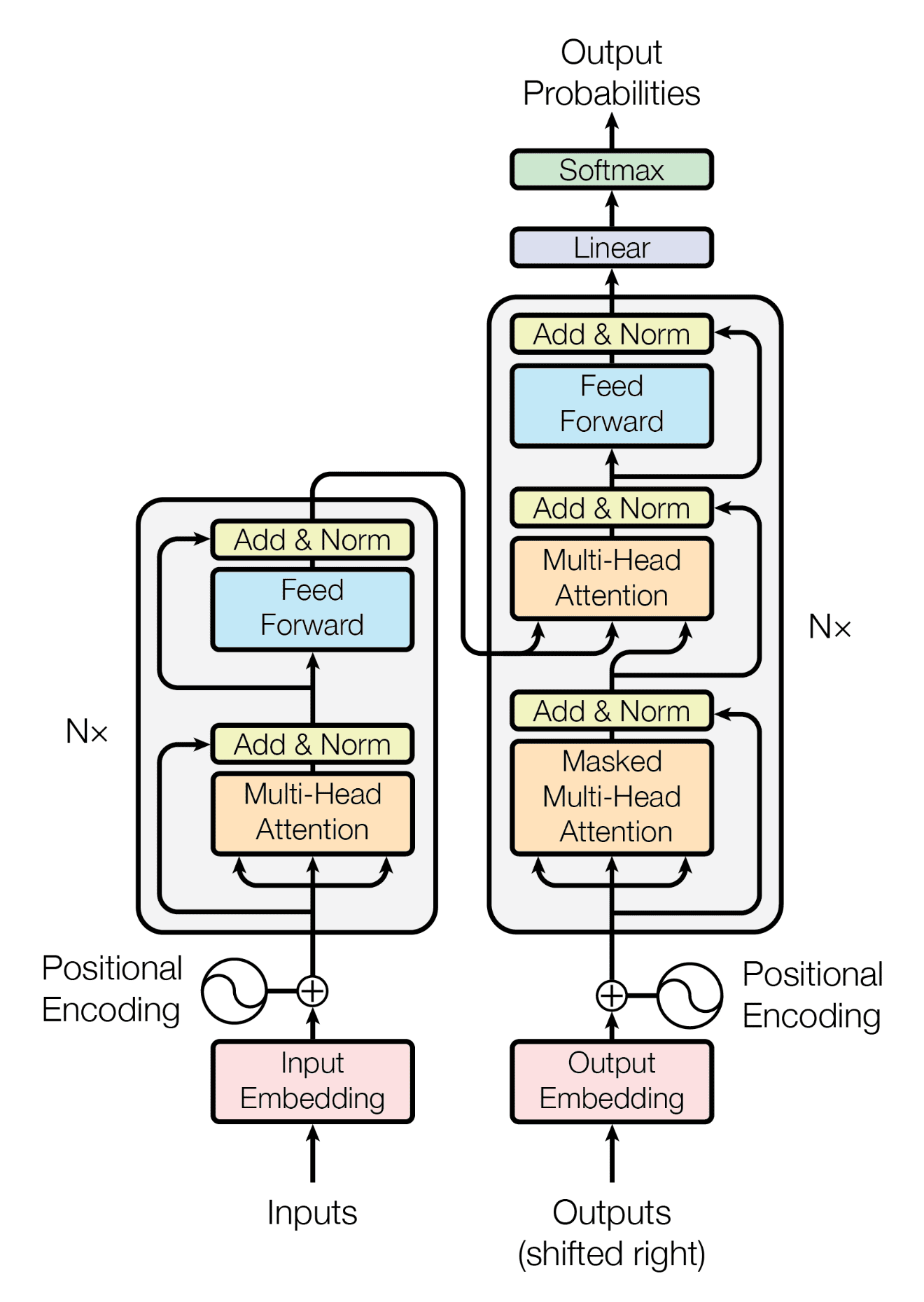This repository contains a from-scratch implementation of the Transformer model, as introduced in the paper "Attention Is All You Need" by Vaswani et al. The model is built using PyTorch and is designed for neural machine translation (NMT).
The code is structured to be clear, modular, and easy to follow, making it a valuable resource for understanding the inner workings of the Transformer architecture.
- Complete Encoder-Decoder Architecture: Full implementation of the Transformer's encoder and decoder stacks.
- Multi-Head Attention: Scaled Dot-Product Attention mechanism with multiple heads.
- Positional Encoding: Sinusoidal positional encodings to inject sequence order information.
- Custom Dataset Handling: Efficient data loading and preprocessing using a custom PyTorch
Dataset(BilingualDataset). - Dynamic Tokenizer Building: Automatically builds
WordLeveltokenizers from your dataset using the Hugging Facetokenizerslibrary. - Training & Validation: A complete training script with a validation loop, checkpointing, and progress bars via
tqdm. - Inference Script: A ready-to-use script to translate new sentences using a trained model.
- Configuration Management: Centralized
config.pyfor easy management of hyperparameters and paths. - TensorBoard Integration: Logs training loss and validation metrics (CER, WER, BLEU) for experiment tracking.
This implementation follows the original Transformer architecture. The model consists of an Encoder stack and a Decoder stack.
- The Encoder maps an input sequence of symbol representations
$(x_1, ..., x_n)$ to a sequence of continuous representations$\mathbf{z} = (z_1, ..., z_n)$ . - The Decoder, given
$\mathbf{z}$ , generates an output sequence$(y_1, ..., y_m)$ one element at a time, using the previously generated symbols as additional input.

The Transformer model architecture from the original paper.
The repository is organized into several key files:
.
├── Model.py \# Contains all PyTorch nn.Module classes for the Transformer architecture
├── Dataset.py \# Defines the custom BilingualDataset for data loading and preprocessing
├── train.py \# Main script to handle dataset loading, tokenizer building, and model training
├── inference.py \# Script for running translation on new sentences with a trained model
├── config.py \# Central configuration file for hyperparameters and paths
└── README.md \# This file
Follow these steps to set up and run the project on your local machine.
Make sure you have Python 3.8+ installed.
Clone the repository and install the required dependencies.
# Clone the repository
git clone [https://github.com/YOUR_USERNAME/YOUR_REPOSITORY.git](https://github.com/YOUR_USERNAME/YOUR_REPOSITORY.git)
cd YOUR_REPOSITORY
# Create a virtual environment (recommended)
python -m venv venv
source venv/bin/activate # On Windows, use `venv\Scripts\activate`
# Install dependencies
pip install -r requirements.txtYou will need a requirements.txt file. Here are the necessary packages based on your code:
requirements.txt:
torch
torchvision
torchaudio
datasets
tokenizers
torchmetrics
tqdm
tensorboard
All hyperparameters, file paths, and dataset settings can be modified in the config.py file. The default settings are configured to train an English (en) to Italian (it) translation model using the opus_books dataset.
# config.py
def get_config():
return {
'batch_size': 8,
'num_epochs': 20,
'lr': 10**-4,
'datasource': 'opus_books',
'lang_src': 'en',
'lang_tgt': 'it',
'seq_len': 350, # Reduced for faster training on standard hardware
'd_model': 512,
# ... other settings
}To start the training process, simply run the train.py script.
python train.pyThe script will:
- Download the dataset from Hugging Face Hub.
- Build and save tokenizers for the source and target languages if they don't already exist.
- Initialize the Transformer model.
- Start the training loop, saving model checkpoints after each epoch.
- Log training loss and validation metrics to a TensorBoard instance.
You can monitor the training process using TensorBoard:
tensorboard --logdir runsOnce a model is trained, you can use inference.py to translate sentences.
# Translate a default sentence ("Hello World.")
python inference.py
# Translate a custom sentence
python inference.py "This is a test sentence."The script also allows you to translate a sentence from the validation set by providing its index:
# Translate the 10th sentence in the validation set and compare with the ground truth
python inference.py 10The output will look like this:
Using device: cuda
ID: 10
SOURCE: I have never seen a man look so helpless.
TARGET: Non ho mai visto un uomo così impotente.
PREDICTED: Non ho mai visto un uomo così indifeso . [EOS]
Model.py: Defines the building blocks of the Transformer:MultiHeadAttentionBlock,FeedForwardBlock,EncoderBlock,DecoderBlock,PositionalEncoding,LayerNormalization, etc. Thebuild_transformer()function assembles these blocks into a full model.Dataset.py: TheBilingualDatasetclass is responsible for taking a raw text pair, tokenizing it, adding special tokens ([SOS],[EOS],[PAD]), and creating theencoder_maskanddecoder_maskneeded for training.train.py: Orchestrates the entire training pipeline, from data acquisition and tokenization to model training and validation. It also handles model checkpointing.config.py: A clean way to manage all model and training parameters without hardcoding them into the scripts.inference.py: Provides a straightforward example of how to load a trained model and use it for greedy-decoding to generate translations.
This project is a personal implementation based on the concepts presented in the following paper:
- Ashish Vaswani, Noam Shazeer, Niki Parmar, Jakob Uszkoreit, Llion Jones, Aidan N. Gomez, Łukasz Kaiser, and Illia Polosukhin. 2017. Attention Is All You Need. In Proceedings of the 31st International Conference on Neural Information Processing Systems (NIPS 2017).
MIT License
Copyright (c) 2025 Arnav Kulshrestha
Permission is hereby granted, free of charge, to any person obtaining a copy of this software and associated documentation files (the "Software"), to deal in the Software without restriction, including without limitation the rights to use, copy, modify, merge, publish, distribute, sublicense, and/or sell copies of the Software, and to permit persons to whom the Software is furnished to do so, subject to the following conditions:
The above copyright notice and this permission notice shall be included in all copies or substantial portions of the Software.
THE SOFTWARE IS PROVIDED "AS IS", WITHOUT WARRANTY OF ANY KIND, EXPRESS OR IMPLIED, INCLUDING BUT NOT LIMITED TO THE WARRANTIES OF MERCHANTABILITY, FITNESS FOR A PARTICULAR PURPOSE AND NONINFRINGEMENT. IN NO EVENT SHALL THE AUTHORS OR COPYRIGHT HOLDERS BE LIABLE FOR ANY CLAIM, DAMAGES OR OTHER LIABILITY, WHETHER IN AN ACTION OF CONTRACT, TORT OR OTHERWISE, ARISING FROM, OUT OF OR IN CONNECTION WITH THE SOFTWARE OR THE USE OR OTHER DEALINGS IN THE SOFTWARE.